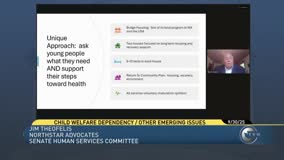Juvenile Rehabilitation officials report overcrowding at Green Hill; Harbor Heights opens and use‑of‑force incidents fall
September 30, 2025 | Legislative Sessions, Washington
This article was created by AI summarizing key points discussed. AI makes mistakes, so for full details and context, please refer to the video of the full meeting. Please report any errors so we can fix them. Report an error »

Juvenile Rehabilitation (JR) leaders briefed the Senate Human Services Committee on capacity, crowding and operational changes at state facilities, with an emphasis on Green Hill School and Echo Glen Children’s Center.
Jennifer Redmond, DCYF’s newly appointed assistant secretary for Juvenile Rehabilitation, told the committee Green Hill’s identified safe operational capacity is 180 residents (single‑bunking plus limited flex space) but earlier this year population reached about 240; as of the committee meeting Green Hill’s population was around 212. JR opened half of Harbor Heights (22 residents) in mid‑2025 and expects the second wing to come online in the following month after required medical‑trailer installation.
Redmond said JR’s population changes quickly and small increases in intakes can sharply affect overcrowded facilities because JR has a relatively small footprint. JR reported several operational interventions to reduce risks during crowded periods: added contracted ancillary security to free JR staff for programming, an incident‑command partnership with the Department of Corrections from Aug. 2024 to March 2025, point‑of‑entry and movement controls on campus, monthly hiring academies and staff training, and program adjustments to keep youth engaged and reduce downtime that can feed incidents.
JR reported improvements: staff injuries have decreased, use‑of‑force incidents have declined (monthly use‑of‑force counts dropped from around 60 in July 2024 to 19 in July 2025), and large‑scale aggression incidents are fewer. JR also emphasized persistent challenges: double‑bunking remains necessary, contracted programming capacity is strained, contraband control is an ongoing difficulty, and staffing call‑outs remain elevated.
TeamChild, a legal‑services organization that represents young people in JR, told the committee it sees several system levers that could reduce population pressure and improve outcomes. Greta Schultz, TeamChild managing attorney, said community minimum‑security facilities are underutilized and urged JR to expand placements there; she also said a community transition/home‑monitoring program funded for 50 youth currently serves only eight (data JR made publicly available). TeamChild raised concerns about sentence extensions that keep youth longer in secure settings, the persistence of referrals from some counties that lead to criminal charges for in‑facility incidents, and family‑connection limitations (for example, client reports that Echo Glen allows two 10‑minute calls per week).
TeamChild also asked JR to clarify and publish written infraction policies and ensure youth meaningful participation in infractions proceedings; the organization said clear, transparent procedures would reduce the sense of unfairness and enable restorative approaches.
Less critical details: JR noted demographic and sentencing patterns—about half of Green Hill’s population serves adult sentences or has release dates beyond age 25—requiring more medium‑security placements and longer‑term programming planning.
Jennifer Redmond, DCYF’s newly appointed assistant secretary for Juvenile Rehabilitation, told the committee Green Hill’s identified safe operational capacity is 180 residents (single‑bunking plus limited flex space) but earlier this year population reached about 240; as of the committee meeting Green Hill’s population was around 212. JR opened half of Harbor Heights (22 residents) in mid‑2025 and expects the second wing to come online in the following month after required medical‑trailer installation.
Redmond said JR’s population changes quickly and small increases in intakes can sharply affect overcrowded facilities because JR has a relatively small footprint. JR reported several operational interventions to reduce risks during crowded periods: added contracted ancillary security to free JR staff for programming, an incident‑command partnership with the Department of Corrections from Aug. 2024 to March 2025, point‑of‑entry and movement controls on campus, monthly hiring academies and staff training, and program adjustments to keep youth engaged and reduce downtime that can feed incidents.
JR reported improvements: staff injuries have decreased, use‑of‑force incidents have declined (monthly use‑of‑force counts dropped from around 60 in July 2024 to 19 in July 2025), and large‑scale aggression incidents are fewer. JR also emphasized persistent challenges: double‑bunking remains necessary, contracted programming capacity is strained, contraband control is an ongoing difficulty, and staffing call‑outs remain elevated.
TeamChild, a legal‑services organization that represents young people in JR, told the committee it sees several system levers that could reduce population pressure and improve outcomes. Greta Schultz, TeamChild managing attorney, said community minimum‑security facilities are underutilized and urged JR to expand placements there; she also said a community transition/home‑monitoring program funded for 50 youth currently serves only eight (data JR made publicly available). TeamChild raised concerns about sentence extensions that keep youth longer in secure settings, the persistence of referrals from some counties that lead to criminal charges for in‑facility incidents, and family‑connection limitations (for example, client reports that Echo Glen allows two 10‑minute calls per week).
TeamChild also asked JR to clarify and publish written infraction policies and ensure youth meaningful participation in infractions proceedings; the organization said clear, transparent procedures would reduce the sense of unfairness and enable restorative approaches.
Less critical details: JR noted demographic and sentencing patterns—about half of Green Hill’s population serves adult sentences or has release dates beyond age 25—requiring more medium‑security placements and longer‑term programming planning.
View full meeting
This article is based on a recent meeting—watch the full video and explore the complete transcript for deeper insights into the discussion.
View full meeting
